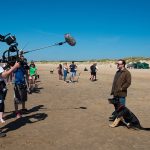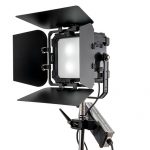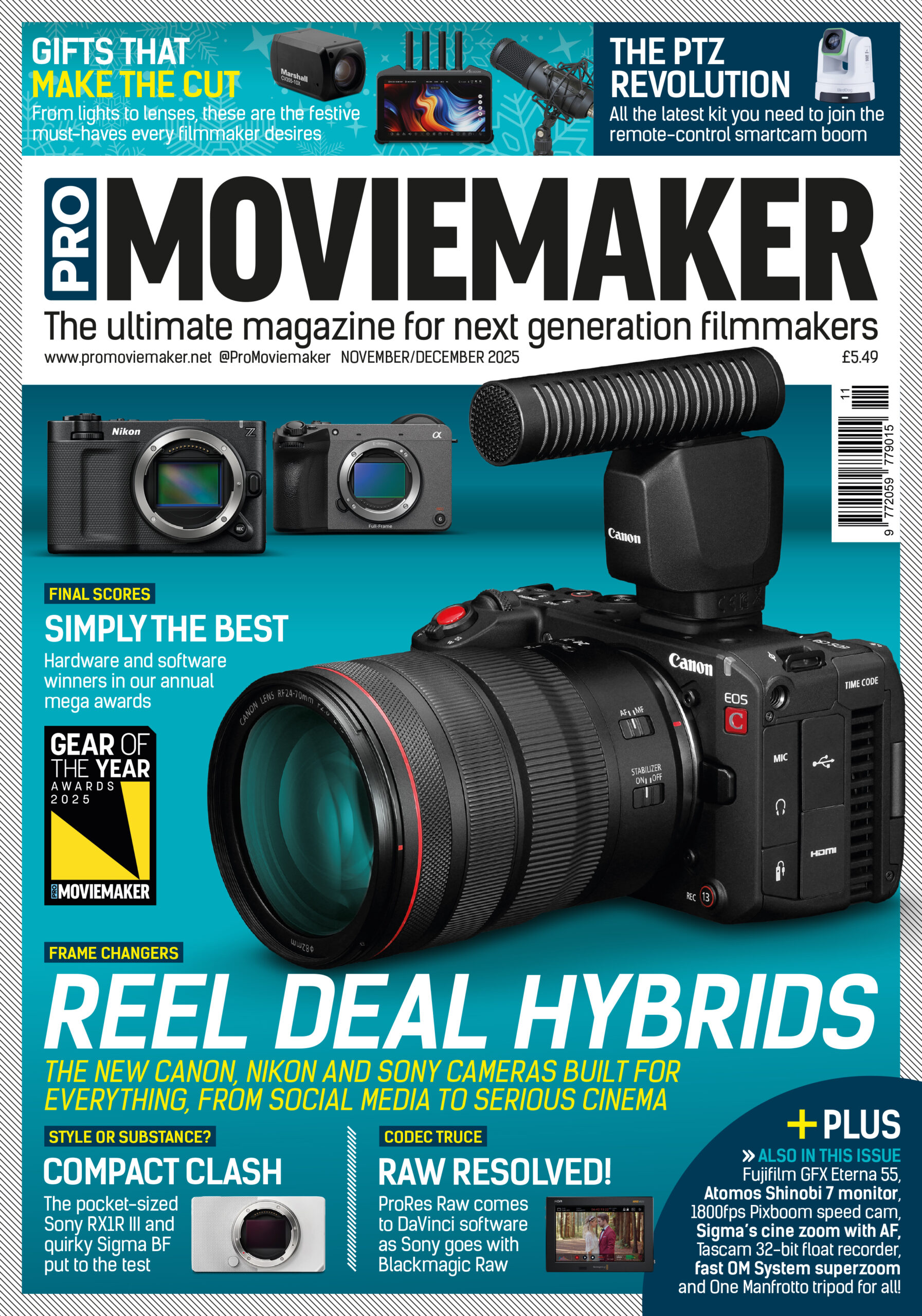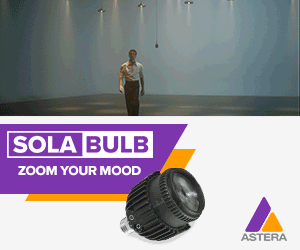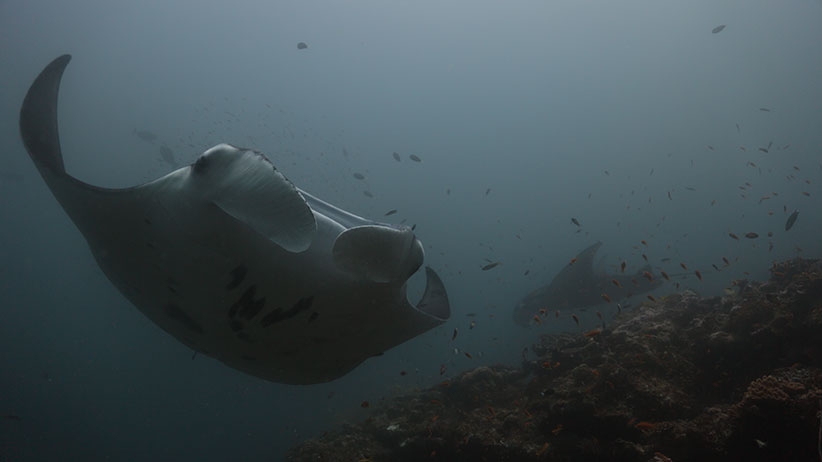
Taking The Plunge
Mark Sharman was in the fortunate position of deciding early in life what his career would be, but actually achieving his ambition to be an underwater filmmaker called for a highly-focused approach.
Words: Terry Hope
Images: Mark Sharman
For many of us it can take a frustratingly long time to work out what career we might want to work towards, leading to all kinds of problems down the line. But for young Mark Sharman there was never any debate. “My interests from an early age were wildlife and scuba diving,” he recalls, “and by the time I left school I was also interested in filmmaking, so the three things naturally dovetailed.”
Following a three-year degree in TV production undertaken at Bournemouth University, Mark then set about making his dream come true. Astute enough to realise that he didn’t have enough practical experience of diving or filming underwater at that stage, he determined to put that right by volunteering to assist the Coral Cay Conservation group, which involved diving and gaining dive qualifications up to divemaster for three months in the Philippines. He then followed this up by spending a further three months in Egypt, scuba diving with tourists and producing a DVD of their activities for them to purchase at the end of their holiday.
“The experience in the Philippines was purely diving,” he says, “because I knew it was necessary to become completely comfortable with that side of things so that, just as you might drive a car almost automatically, I didn’t even really have to think about it anymore. It can take you that amount of time and several hundred dives to master neutral buoyancy, which is crucial, while at the same time I was also learning how to identify the various fish and invertebrate species that I was encountering.
“By the time I arrived in Egypt I felt that I could now concentrate totally on the filmmaking side of things without having to worry about my scuba gear. The equipment I had with me was pretty basic to say the least. I was filming with a Sony PD150 camcorder that was encased in a Sea & Sea housing, but it all worked fine and I was able to get some really decent underwater footage with that set-up.”
Back in the UK Mark started to look for work, determined to focus on positions related to wildlife. His degree helped him to land temporary positions at places such as the BBC where, to his delight, he undertook a three-month role as a researcher on The Really Wild Show, one of the programmes that had inspired him to become interested in nature in the first place.

Mark Sharman filming bajau fishermen in Indonesia for the BBC/Netflix film, Jago: A Life Underwater.
“It was great to get that experience,” he says, “but I had already realised by this point that, to make a career in the field I wanted to be in, I had to set up as a freelancer and to take jobs on as and when they came through. That’s very much still the way I operate these days, and it’s a mixture of networking, building up contacts, putting together proposals and being ready to head off all over the world at short notice. I’m travelling for between 120 and 150 days a year and it can take between two and three weeks to put together a sequence for a programme such as Blue Planet II. Sometimes you get nothing for the first two weeks and everything happens on the last day: there have been a few of those. Developing patience and remaining upbeat and positive when the chips are down are key skills to master.”
Regularly working on high-profile productions for some of the world’s leading wildlife filmmakers, Mark’s CV is testament to the international regard with which he’s held. Credits include filming bajau fishermen in Indonesia for Jago: A Life Underwater (BBC 4 and Netflix) and One Strange Rock for National Geographic, filming humpback whale behaviour off the cost of Colombia for Blue Ant Media/Love Nature, tagging cameras on to mobula rays for Animals with Cameras, being part of the BBC team filming back stories for Wild Alaska Live, undertaking landmark underwater shoots for Blue Planet II, filming underwater rescue dogs for the Discovery Channel’s Dogs: The Untold Story and contributing wildlife sequences for the Davina McCall: Life at the Extreme series.

Although he specialises in underwater footage, Mark Sharman also regularly films wildlife scenes topside.
“Developing patience and remaining positive and upbeat when the chips are down are key skills”
Continual Learning
Also on the agenda if you want to remain on the radar of the commissioners is the ongoing acquisition of new skills, some of them complementary but others less so. “I’m continually having to develop my craft and push new boundaries to keep up my skills as an all-round cameraman,” says Mark, “both on land and underwater. Becoming a rebreather diver was an important step, as it is allows you to spend a lot more time underwater and to get closer to certain marine life. That was like learning diving from scratch, and it requires neutral buoyancy to be relearned in a new way.
“Latterly I’ve qualified as a drone pilot so that I’m able to fly and film aerial sequences, and these skills need constant refinement and practice to be able to perform and deliver on demand when the action is happening. I own a DJI Phantom 4 Pro and also fly the Inspire 2, and this particular skill is now something that more and more clients expect you to have. It’s completely changed the landscape, and where once you would have had to hire in a helicopter to get a shot now you simply put a drone up in the air and you can have the footage you need in a matter of minutes.”




A sequence, including footage of a male cuttlefish displaying, shot in the beautiful clear waters around Malta.
“I’m continually having to develop my craft and push new boundaries as an all-round cameraman, both on land and underwater”

Mark Sharman is equally at home filming larger creatures such as a killer whale.
Underwater filming is still very much Mark’s speciality however, and his kit has evolved over the years to take account of the changing face of technology. “When I was starting out around the turn of the century, the hardware required for underwater filmmaking was hugely bulky and ultra-expensive,” he says. “Now kit is much more affordable and easier to work with and it makes life easier for those looking to specialise in this area, while it also means that I’m continually checking out what’s available to see if it can add something to my business.”
At the heart of Mark’s current outfit are two Sony FS7s, chosen for their relatively compact size and weight combined with quality of output. “The reason that I’ve got two of these is that one of them is for topside filming while the other is pretty much permanently encased in a Sealux housing, and it would be time-consuming and fiddly to take it out and then put it back in again.”
The housing, which was initially purchased at the start of a five-week filming job in Oman, is a crucial part of the entire operation, featuring levers on the outside that can control all the FS7’s operations underwater, while there’s also a separate housing for an Odyssey 7Q+ monitor/recorder. The set-up is fairly compact and is beautifully balanced, meaning that it’s straightforward to use and doesn’t feel unwieldy.
Interestingly Mark has decided to work extensively with zoom lenses both underwater and topside, chiefly because it allows him to react quickly to his subjects, while changes of viewpoint underwater would clearly be impossible without the ability to seamlessly move between focal lengths.
“Up until now I’ve been working with a selection of Canon EF lenses,” he says, “a 16-35mm, 24-70mm and 70-200mm. They need to be used with an adapter, which is not ideal, and of course they are stills camera lenses, which again means they’re something of a compromise. I also use a Nikon 17-55mm on a RED Dragon underwater with a Metabones adapter, and although this is also a photographic lens it’s been used a lot because it offers a very useful zoom range that’s ideal for the kind of things that I’m doing.”

“These are dedicated cinema lenses with all the benefits this offers the filmmaker”
Always on the lookout for kit that might benefit his operation, Mark took a keen interest when Fujifilm announced the launch of its MK zoom pair, the 18-55mm and 50-135mm, both T2.9, last year, and the fact that they were supplied in Sony fit made him all the more determined to try them out.
“I was intrigued by the fact that these are dedicated cinema lenses with all the benefits this offers the filmmaker,” he says, “plus they would fit directly to the FS7 without the need for any adapters. They were also much more affordable compared to previous Fujifilm cinema zooms, and so I decided to try them out for my topside work for Wild Alaska Live.
“Another early experience was a job working on a Shark Week project for the Discovery Channel in the Bahamas. I was filming topside and using a drone from a boat for the duration, so camera and lens choice was crucial, and the MK pair did a great job. As well as giving me the ‘look’ I was after I wanted to undertake some on-the-shoulder sync filming, which is very dependent on the overall weight of the kit. With each lens weighing in at 0.9kg – which is remarkably light for a lens of this type – it made for a much more comfortable set-up. That’s a hugely important factor when you’re working across the length and breadth of a boat for long hours, late into the evening.”
In time Mark aims to adapt his housing with a port extension and a lever to allow manual adjustment of the 18-35mm MK’s non-electronic aperture, and once this is done the shorter of the two zooms will become his underwater lens of choice.

Swimming with rays was a stand-out experience for Mark Sharman, as he got underneath, highlighting them against the bright sky.

Getting Close to Nature
For anyone who is passionate about wildlife, the thought of working up close and personal to some of the world’s most iconic species sounds almost too good to be true, but there are times when things can get just a little too real.
“Filming large marine life has been my most thrilling experience so far,” says Mark. “It really reminds you of your size and place. I’ve filmed beside whale sharks, sperm whales, humpback whales and orcas which were all memorable experiences. I’ve also had a brown bear mother walk her two young cubs right past where I was sitting.
“In my experience all these wild animals are generally quite shy and move away from you, so when the odd one allows you to stay close and film for a few minutes, they are really special moments. I don’t see the natural world as a scary place; wildlife is often misunderstood and sensationalised in the media, so I have a healthy respect for something that could do me harm.
“Ultimately you’re in their domain so you have to move and act accordingly, take advice from experts, and everyone is happy,” explains Mark. “The only time I was ever genuinely threatened in the wild was when we had an encounter with poachers whilst on patrol with eco guards in Gabon. I filmed the capture of a poacher while being shot at by the guys who ran away, and it wasn’t until after the adrenaline had worn off that I thought about the danger we had been in.”
So, is there any advice that Mark would pass on to those who might be considering following in his footsteps? “It’s going to be a long haul,” he says, “so building resilience to setbacks is key. There will always be double the number of knock-backs as there will be big breaks, so you’ve just got to keep going and look for different angles.
“It’s a very competitive area to get into, so a deep and unshakable passion is needed. Getting any experience in the industry is a good move, taking every opportunity to learn and develop the craft with hands-on experience. Meet as many people as possible in the industry and then make sure that you take the time to keep in touch with them.
“Most of my work comes from recommendation, by reputation and from people I already know,” he concludes, “so the bigger the network you can put together, the more chance there is of work coming in. Also take on board the fact that clients prefer working with nice people, so being easy and fun to deal with will also give you a big advantage.”

Equally memorable was the opportunity to film around dolphins, including this encounter with a mother and her calf.
>>More Information
www.marksharman-cinematography.com

